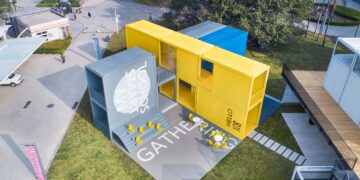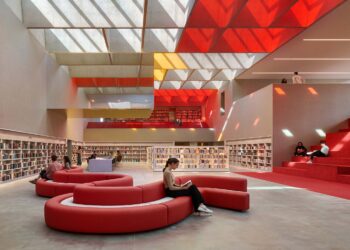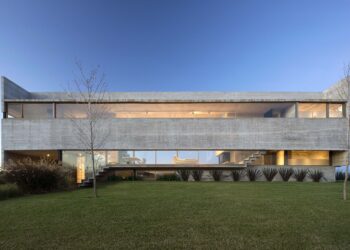An intriguing house that projects both introversion and openness
조형적인 콘크리트 캐노피가 부여하는 내향성과 개방성, N-DP 주택
GRAUX & BAEYENS Architecten | 그락소 & 베이언스 아키텍튼

This house, along the Leuvense Vaart in Mechelen, Belgium, demonstrates a seemingly random play of asymmetrical concrete canopies, which open and close the façade, creating an impression of both introversion and openness.
The dynamics created by the angled concrete canopies and the sophisticated positioning of the triangular storeys was designed in response to the environment in which the house was built, in this case, a narrow and deep plot with close proximity to neighbouring properties, but also with an expansive view of the canal and the fields behind it.
벨기에 북부에 위치한 도시 메헬렌. 루벤스 운하가 흐르는 아름다운 풍경 속에, 운하와 그 너머에 펼쳐진 들판을 향해 탁 트인 전망을 품은 주택이 둥지를 틀었다. 멀리서 보면 마치 거대한 암석 같은 강한 인상을 풍기지만, 안으로 들어가면 비대칭적으로 절개된 콘크리트 캐노피 사이로 눈높이에 맞춘 풍경을 즐길 수 있는 매력적인 집이다. 속살을 드러내기도 하고 감추기도 하는 독특한 캐노피는 이 집에서 가장 눈에 띄는 조형적 요소이자, 내향성과 개방성을 동시에 부여하는 건축적 요소이기도 하다. 캐노피를 층마다 조금씩 각도를 틀면서 쌓아 올림으로써 건물에 역동적인 느낌을 더한 것이다. 뿐만 아니라 틀어진 각도 덕분에 이웃 건물들이 가까이 자리함에도 거주자의 사생활은 보장된다.





Each story is set back in relation to the previous one and has been superimposed at a slightly shifted angle, with the intention of creating privacy and a sense of security for the residents. This fan-like movement inward also creates a playful effect that counters the monolithic appearance of the nine meter high building. At the same time, the fan shape is intended to cast as little shadow as possible on the neighbours. The breaches in the concrete walls in turn create exciting openings to the garden and the water. While the concrete construction is no less imposing than the ships that slowly pass by on the canal, the openings give the whole a human scale.
가장 아래층에는 차고를 배치하였으며, 지나가는 사람들의 눈에 띄지 않도록 주택의 입구를 숨겨 놓았다. 커다란 회전문은 집 안으로 들어온 사람들을 따스하게 맞이한다. 화장실과 세탁실을 지나 건물 중심인 콘크리트 계단으로 공간의 흐름을 따라 올라가 보면 2층에 자리한 거실과 부엌을 만나게 된다. 아침이 되면 창으로 들어온 햇살이 부엌으로 쏟아지고, 저녁이 되면 테라스가 딸린 거실이 붉게 물든다. 삼각형의 모서리에 맞춤형 수납장과 벽난로를 짜 공간을 활용한 것 또한 인상적이다. 거실 뒤편으로 한층 더 올라가면 역시 테라스가 딸린 부부와 아이들을 위한 방이 자리한다.





The concrete from which the house is built also forms the supporting structure. This makes it possible for the opening movement of the façades to be continued in the interior.
The lowest concrete wedge serves as a carport and hides the entrance of the house from the view of passers-by. However a large pivoting door and concrete step offer a welcoming entrance. The stairs, together with a cloakroom and laundry room, are located in the concrete core of the house and lead to the living areas that nestle around the central part on the first floor in a single, flowing movement. The kitchen enjoys morning sun, while the living room with adjoining terrace catch the evening sun.
내향성과 개방성과 공존하는 이 주택의 이중적 성향은 내외부에 사용한 재료에서도 느낄 수 있다. 외부는 콘크리트로 통일해서 절개 부위를 부각하고 하나의 질감으로 차가움을 표현한 반면, 내부는 콘크리트, 목재, 회반죽의 균형 잡힌 사용으로 따뜻한 분위기를 연출한 것이다. 외부 테라스 계단은 아연 도금 강과 같이 가벼운 재료로 만들어 육중한 콘크리트와 대비를 이뤘다. 거친 콘크리트 바탕에 삼각형의 변형으로 만든 내향성과 개방성, 다양한 재료의 혼합으로 세심함을 살린 집이다.



The symbiosis between secure enclosure and openness also comes into its own in the interior, through the use of understated materials, alternating the warm texture of clay plaster on walls and ceilings with the raw concrete and wooden finishing.
The tranquil material palette has been carried over into the smallest details, including the galvanised steel balustrades. This aligns the enclosure and the breaches in the façade with the human scale of the residents, in an otherwise imposing building. The steel of the balustrades is reflected in the external staircase and gate, which were specially designed for this house.




Project: House N-DP / Location: Mechelen, Belgium / Architect: GRAUX & BAEYENS architecten / Use: Private House / Site area: 2,442m² / Built area: 474m² / Exterior materials: concrete cast-in place, afrormosia wood, galvanized steel, custom design by GBA, afrormosia planks, Mastersystems, Fakro / Interior materials: lime plaster, polished concrete, invisible doorframes, walnut veneer, custom design by GBA, mortex, Rosco / Completion: 2019 / Photograph: ©Filip Dujardin




































